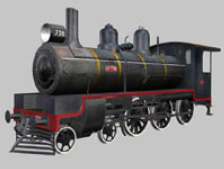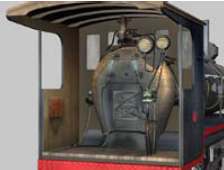CCG/Modelling: PolyCount
Contents |
POLYCOUNT
3D STUDIO MAX MODEL GUIDELINES
This page contains an outline of the mesh asset polycount guide for the various types of assets. Of course being a `real-time' 3D engine we strongly suggest you keep the polygon count to a minimum.
In other words - in what environment is the asset being used? Do you have a single house in the middle of a desert or is the house surrounded by trees, power lines, other houses and buildings, a train track and a 100,000 polygon full train consist zipping by every 10 minutes?
Based on this thought, then consider the following:
User system variations and/or User system Performance.
- If you need a ladder, use alpha mask maps, if you need a steel structure, use alpha mask maps, if you want to model a signal pole only use a 5 sided cylinder, if a locomotive has lots of pipes and handrails, make the pipes 3 or 4 sided with welded vertices.
- Please note that the Trainz meshes have no support for the smoothing groups in 3DSMax. Use welded vertices to achieve the effect.
- In Trainz, introduce assets gradually - if you were approaching a forest with a number of different types of trees, introduce a few of each type in the scene before you get to the main forest. Trainz will then have the trees loaded into memory gradually, instead of suffering the frame rate impact of many assets having to be loaded in a short time.
The following table will give you a guide for creating your models. Slight variations to these are possible but it is not advisable for example to use 17,000 polygons for a locomotive body.
MESH POLYCOUNT GUIDE
These poly counts are for Trainz Classics.. Later Trainz versions support higher counts
|
KIND |
MAX POLYCOUNT |
NOTES |
| Locomotive Interiors | 8,000 each | Diesel or steam loco's. Including all levers, dials and animations, & bonnets (hoods for our American friends). |
| Locomotive Body (diesel) | 9,000 each | This should be sufficient for all diesel loco's - excluding bogeys, pantographs etc. For example, the `qR 2100' body currently in Trainz has less than 5000 polys. Less is always better! |
| Locomotive Body (steam) | 12,000 each | This should be sufficient for very detailed steam locos - excluding bogeys, etc. (see images at bottom of page). |
| Locomotive Bogey (diesel) | 2000 per truck | . . |
| Locomotive Bogey (steam) | 5,000 per driving wheel set | Including all rods and animated parts. Less is always better! Should be sufficient enough for most steam bogeys. |
| Pantographs | 1,000 each | On average pantographs will have about 400-700 polys. |
| Passenger Rolling stock | 2200 each | This should be sufficient for a passenger car with window cut-outs, a low poly interior with seats (visible from the exterior), and animated doors. |
| Hopper Rolling stock | 1400 each | This should be sufficient for most Hopper cars, inclusive of load and animated doors. |
| Flat, box and tank Rolling stock | 1100 each | This should be sufficient for most cars, inclusive of load and animated doors where applicable. |
| Rolling stock Bogeys | 400 each | Rolling stock bogeys must be kept to a minimum. Make the bogey sides basic, even masked alpha mapped only. |
| Level Crossing | 350 each | Based on a simple road/track crossing with animated boom-gates and signals. |
| Single Caternary | 200 each | Based on per pole structure. |
| Semaphore Signal post | 300 each | Ladders should be 2-sided masked alpha mapped. |
| Coloured light Signal post | 300 each | Ladders should be 2-sided masked alpha mapped. |
| 3D Passengers | 140 each | |
| Typical House | 150 each | The 'Australian houses' currently in Trainz average about 150 polygons. |
| Typical Large Building | 300 each | |
| Other Scenery Objects | Varies | Just don't go overboard! Put the detail in the textures. Remember not to go overboard with the texture sizes either! 512x512 pixels is too big for a house.
The German Lumber Yard for example, including it's forklift and scary looking driver, came to only 1714 polys. The logs are 5 sided cylinders, the dominant chimney stack is an 8 sided cylinder, which is fine for objects viewed from a reasonable distance. |
| SHADOW: Loco | 700-900 each | Just enough to model loco form (usually including buffers) |
| SHADOW: Passenger cars | less than 300 | |
| SHADOW: Tank cars etc | less than 500 | |
| SHADOW: Bogeys | less than 100 | Simple box and wheel faces are usually enough |
The images above are examples of the kind of detail you can get within the polygon boundaries above.
Body: 10,578 polygons (hi-res L.O.D. version)
Front bogey: 696 polygons
Rear bogey: 4018 polygons
TOTAL: 15,292 polygons (body & bogeys)
With respect to Level of Detail, this locomotive's polygons can be reduced very easily:
- The pipework, valve and gauge details within the cab equate to 4775 polygons;
- The pipework and handrails on each side of the boiler equate to 948 polygons;
- The coupling and pipe at the front equate to 459 polygons;
Removing these items within the LOD files means a body reduction of 6182 polygons without any loss of form.
There are more examples of cab interior polygon counts on Page 358.
In summary, train body polygon recommendations (excluding bogies):
- Diesel loco = 3500-9000 polygons.
- Steam loco = Up to 12000 polygons.
As a general rule of thumb, less is always better from a performance viewpoint!
Train body shadow polygon recommendations:
- Less than 1000 polygons modeled to the same basic shape and 3D space as the body. No attachments are required within the shadow file. Holes in the shadow mesh (windows for instance) can cause streaks of grey from the model windows to the shadow on the ground - fill in all holes in the shadow mesh.


